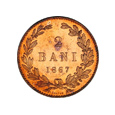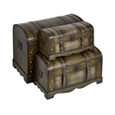JEWELS FROM THE MEDIEVAL TREASURE AT ȚIFEȘTI
Text: dr. Silviu Oța / photo: Marius Amarie.
The treasure was discovered in 1912, when replanting a vineyard belonging to N. Angonescu, from Țifești village, on the Putna river, 18 km away from Focșani. It appeared at a depth of -0.40 m and, according to the testimony of the discoverer, it had been laid in a hollowed rivermstone, covered by another one. It contained silver coins, silver jewellery and traditional costume items. It is about two pairs of earrings, eight filigree silver wire buttons and other two made of two silver foil caps, decorated with granules. The coins were issued by the Ottoman Empire, during the time of the sultans Mahomed II (1451-1481) and Bayezid II (1481-1512) and in the Kingdom of Hungary, during the time of the kings Matthias Corvinus (1458-1490) and Vladislav II (1490-1516). The treasure was purchased by the Numismatic Cabinet of the Romanian Academy. Insofar as the buttons are concerned, they are made in different manners. According to the publication from 1916, the first model was made of silver foil, pressed in the shape of hemispheres that were later jointed. In the lower part, the decoration consists in a pyramid made up of four granules. These items were never returned and their place was taken by three other button halves, made by casting. The second model was made up of filigree silver wire, wrapped in the shape of a yarn ball. The base of the items was also decorated with a pyramid made up of four silver granules, jointed to a circle of spiralled wire. Such accessories are known throughout Romania especially due to the discoveries at Orașul de Floci, Zăvoaia, Baia, Vadu Anei and Târgu Trotuș. The absolute chronology of these items indicates their dating especially during the 15th and 16th century. The earrings have two representative models. The former has a simple wire hook, flattened and perforated at one end. The other one is also flattened and bent towards the outside like a loop. The main decoration consists in two granular formations, between which there is a third one made of looped wire. The additional decoration is made up of two silver plates jointed to the rod and adorned with filigree wire, spiralled wire tubes and clusters of granules. While the way in which the hook is made indicates rather clearly the influence of the Russian workshops, the central decoration is typical to the Balkan space of the 14th and 15th centuries (there are analogies with Drobeta-Turnu Severin, Târgu Trotuș, Vaslui, Bucharest-Bârzești, Retevoiești, Măicănești). The auxiliary plates were adopted in South-Eastern European jewellery craftsmanship during the 14th century, being used up to the 16th century. Some of the items also have a circular cassette in which a coloured glass bead or a flattened decorative plate has been fitted, similarly to the items from Jiana Mare, Olteni, Orșova, Jidosița. Towards the end of the 15th century, this type of decoration became rarer and rarer and was replaced with a plate adorned with spiralled wire little tubes (Orașul de Floci, Țifești, Drobeta-Turnu Severin, Schinetea), which was also used in parallel, but more rarely (Jidosița). The second pair of earrings has the hook similarly made, but without having one of its ends flattened and perforated.
The opposite one was bent towards the inside of the hook, forming a loop. The auxiliary decoration is similar to the preceding items, differing in the fact that one of the two plates is a bit shorter. The central setting, shaped like an ellipsoid, is decorated using the filigree and granular technique, but spiralled wire was used, too. This model was also adopted during the 14th century and it was assumed that its reaching the Middle and Lower Danube area had to be attributed to the Italian masters brought here by the Hungarian royalty. The earliest items decorated in this manner come from Vărădia, Jiana Mare, Orșova, Drobeta-Turnu Severin and Olteni. They can be dated back to the 14th century and the beginning of the 15th century. To the South of the Danube, they are concentrated in Eastern Serbia and Western Bulgaria, in Zaječar, Dobri Do and Gorna-Bela Reka, for example.
Their discovery in the Eastern side of Romania, where they were dated a bit later, suggests that it is possible for the models to have reached the Italian colonies in the Lower Danube. Even more carefully executed items can be seen in treasures such as the one in Schinetea or on a pair of earrings found in the collection of the Romanian National Museum of Art. The fact that the pendants and the central decorations appear on rods typical for the Russian environment, adopted in Moldavia, can lead to the assumption that a part of the items were assembled there, while it is highly likely that some of them reached our territory separately. It is also likely that some items are imitations of Italian pieces, made in local workshops. In addition, the treasure transferred to the National Museum of Romanian History contains three halves of buttons, made by casting, which do not correspond to the items published by C. Moisil in the 1916. It is possible that the buttons discovered in 1912 were accidentally replaced by others at the time of the restitution of the treasure, which had been in Moscow from 1916 to 1956.












